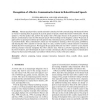2047 search results - page 109 / 410 » The limits of speech recognition |
ICMCS
2005
IEEE
14 years 2 months ago
2005
IEEE
Emotion recognition grows to an important factor in future media retrieval and man machine interfaces. However, even human deciders often experience problems realizing one’s emo...
INTERSPEECH
2010
13 years 3 months ago
2010
Recently, Deep Belief Networks (DBNs) have been proposed for phone recognition and were found to achieve highly competitive performance. In the original DBNs, only framelevel info...
CSL
2010
Springer
13 years 9 months ago
2010
Springer
Recently, discriminative training (DT) methods have achieved tremendous progress in automatic speech recognition (ASR). In this survey article, all mainstream DT methods in speech...
KBS
2006
13 years 8 months ago
2006
Spoken dialogue systems can be considered knowledge-based systems designed to interact with users using speech in order to provide information or carry out simple tasks. Current s...
AROBOTS
2002
13 years 8 months ago
2002
Human speech provides a natural and intuitive interface for both communicating with humanoid robots as well as for teaching them. In general, the acoustic pattern of speech contain...

